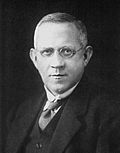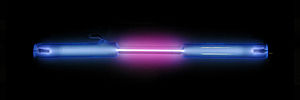The Brønsted–Lowry theory (also called proton theory of acids and bases) is an acid–base reaction theory which was first developed by Johannes Nicolaus...
16 KB (1,895 words) - 06:24, 7 October 2024
A conjugate acid, within the Brønsted–Lowry acid–base theory, is a chemical compound formed when an acid gives a proton (H+) to a base—in other words,...
13 KB (1,298 words) - 13:45, 10 November 2024
are called the acid–base theories, for example, Brønsted–Lowry acid–base theory. Their importance becomes apparent in analyzing acid–base reactions for...
36 KB (4,969 words) - 08:10, 10 September 2024
di-t-butylpyridine and tiny proton. Acid Base (chemistry) Acid–base reaction Brønsted–Lowry acid–base theory Chiral Lewis acid Frustrated Lewis pair Gutmann–Beckett...
22 KB (2,754 words) - 17:47, 24 October 2024
developing the Brønsted–Lowry acid–base theory; he developed the theory at the same time as (but independently of) Martin Lowry. Brønsted was born in Varde...
7 KB (638 words) - 15:51, 18 November 2024
In acid catalysis and base catalysis, a chemical reaction is catalyzed by an acid or a base. By Brønsted–Lowry acid–base theory, the acid is the proton...
7 KB (883 words) - 07:00, 15 January 2024
of the word "base": Arrhenius bases, Brønsted bases, and Lewis bases. All definitions agree that bases are substances that react with acids, as originally...
26 KB (3,041 words) - 06:18, 8 August 2024
Martin Lowry CBE FRS (/ˈlaʊri/; 26 October 1874 – 2 November 1936) was an English physical chemist who developed the Brønsted–Lowry acid–base theory simultaneously...
5 KB (566 words) - 10:51, 18 October 2024
Amphoterism (category Acid–base chemistry)
in Brønsted–Lowry acid–base theory. For example, amino acids and proteins are amphiprotic molecules because of their amine (−NH2) and carboxylic acid (−COOH)...
9 KB (1,473 words) - 13:50, 30 October 2024
known as Arrhenius acids. Brønsted and Lowry generalized the Arrhenius theory to include non-aqueous solvents. A Brønsted or Arrhenius acid usually contains...
47 KB (5,956 words) - 18:26, 8 July 2024
Hydrolysis (redirect from Acid Hydrolysis)
discussion of what occurs during such a hydrolysis, see Brønsted–Lowry acid–base theory. Acid–base-catalysed hydrolyses are very common; one example is the...
18 KB (2,238 words) - 16:16, 1 November 2024
basic solvent, and an acid which is weak in water may be strong in a more basic solvent. According to Brønsted–Lowry acid–base theory, the solvent S can...
19 KB (2,596 words) - 17:05, 11 October 2024
Neutralization (chemistry) (redirect from Acid-Base neutralization)
a quantitative reaction. A more general definition is based on Brønsted–Lowry acid–base theory. AH + B → A + BH Electrical charges are omitted from generic...
17 KB (2,158 words) - 08:31, 11 November 2024
An acid–base titration is a method of quantitative analysis for determining the concentration of Brønsted-Lowry acid or base (titrate) by neutralizing...
24 KB (2,675 words) - 17:24, 5 November 2024
Marcus theory — Lewis theory (successor to Brønsted–Lowry acid–base theory) — HSAB theory — Debye–Hückel theory — Thermodynamic theory of polymer elasticity...
38 KB (4,356 words) - 13:13, 6 November 2024
many choose to activate dyes in acid dye-baths instead. According to the Brønsted–Lowry acid–base theory, an acid is a molecule or ion capable of donating...
11 KB (1,298 words) - 18:15, 11 February 2024
positively charged protons, which is the definition of a base according to Brønsted–Lowry acid-base theory. Additionally, highly polarizable nucleophiles will...
10 KB (1,372 words) - 13:19, 31 May 2023
Hard/Soft Acid Base (HSAB) theory, the bare hydron is an infinitely hard Lewis acid. The hydron plays a central role in Brønsted–Lowry acid–base theory: a species...
9 KB (1,052 words) - 23:39, 27 October 2024
Mechanochemistry Photoredox catalysis Acids and bases Brønsted–Lowry acid–base theory Acid dissociation constants Lewis acids and bases Chemoselectivity Molecular...
8 KB (576 words) - 12:14, 30 October 2023
Hydrogen compounds (section Protons and acids)
proton. This species is central to discussion of acids. Under the Brønsted–Lowry acid–base theory, acids are proton donors, while bases are proton acceptors...
14 KB (1,492 words) - 18:20, 15 July 2024
However a more explicit description is provided by the Brønsted–Lowry acid–base theory, which specifies that the proton H+ does not exist as such...
9 KB (1,309 words) - 19:07, 16 February 2024
solutions of an acid HA, the base is water; the conjugate base is A− and the conjugate acid is the hydronium ion. The Brønsted–Lowry definition applies...
103 KB (11,513 words) - 22:40, 15 October 2024
other elements. Brønsted–Lowry acid–base theory is an acid–base reaction theory which was proposed independently by Johannes Nicolaus Brønsted and Thomas Martin...
279 KB (31,753 words) - 16:09, 13 September 2024
deprotonated acid or an anion An: any actinide B: A base, often in the context of Lewis acid–base theory or Brønsted–Lowry acid–base theory E: any element...
64 KB (2,126 words) - 12:28, 14 October 2024
Hydrogen (section Protons and acids)
proton. This species is central to discussion of acids. Under the Brønsted–Lowry acid–base theory, acids are proton donors, while bases are proton acceptors...
121 KB (12,377 words) - 14:27, 16 September 2024
PH indicator (redirect from Acid-base indicator)
"Ind+" for the conjugate acid of the indicator. The ratio of concentration of conjugate acid/base to concentration of the acidic/basic indicator determines...
19 KB (1,670 words) - 15:01, 3 November 2024
in water, and a base is one that produces hydroxide ions when dissolved in water. According to Brønsted–Lowry acid–base theory, acids are substances that...
83 KB (9,193 words) - 01:13, 26 October 2024
Occupants of the chair to date have been: Martin Lowry (1920–1936), proposed the Brønsted–Lowry acid–base theory Ronald G. W. Norrish (1937–1965), Nobel laureate...
3 KB (287 words) - 11:01, 15 November 2024
Chemical reaction (redirect from Metal-acid reaction)
the Brønsted–Lowry acid–base theory, an acid–base reaction involves a transfer of protons (H+) from one species (the acid) to another (the base). When...
66 KB (8,043 words) - 01:08, 14 October 2024
polar aprotic solvents, are far more basic on the basis of the Brønsted–Lowry acid–base theory. A stoichiometric mixture of caesium and gold will react to...
93 KB (10,025 words) - 01:18, 22 November 2024













